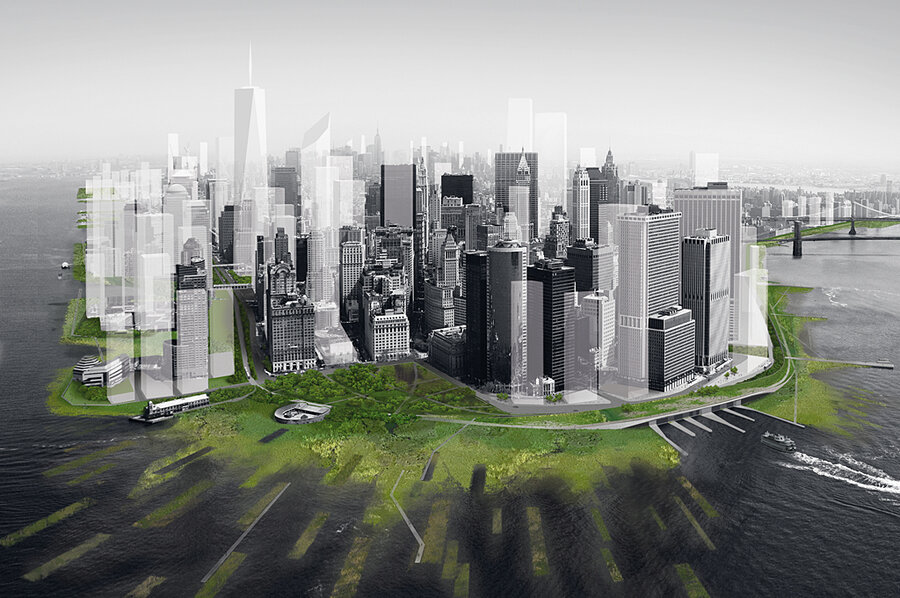How will New York keep out a rising sea? Dikes, huge sea wall, oyster beds?
Loading...
| New York
During superstorm Sandy, a swollen New York Bay overflowed into Manhattan, flooding subways, tunnels, and a major power substation.
But what if the storm surge had been stopped by a five-mile-long barrier outside the harbor? Or what might have happened if New York had built marshes and oyster beds at the tip of Manhattan that had absorbed some of a storm surge's energy?
In the wake of New York's worst natural disaster in modern times, city and state officials are beginning to consider longer-term solutions to prevent a recurrence of the flooding.
"Climate change is a reality," Gov. Andrew Cuomo (D) said during one of his post-Sandy briefings. "Given the frequency of these extreme weather situations we have had, for us to sit here today and say this is a once-in-a-generation [storm] and it's not going to happen again, I think would be shortsighted."
Even before Governor Cuomo's pronouncement, Halcrow Group, a British company that works on infrastructure projects worldwide, in 2009 proposed a five-mile fixed barrier stretching from Sandy Hook, N.J., to Breezy Point in the Big Apple borough of Queens.
Meanwhile, "Rising Currents: Projects for New York's Waterfront," presented by the city's Museum of Modern Art (MoMA) two years ago, among other things asked architects to imagine new ways of using "soft" methods to cope with rising sea levels.
And New York City has had engineers examining ways to address the prospect of rising sea levels for a city with many low-lying areas.
The first step in deciding what to do should be the formation of a harbor protection commission, says Vishaan Chakrabarti, an architect and professor of real estate development at Columbia University here. "We need to include all levels of government," he says. "We need to get the right business and civic voices involved so we can get a broad consensus."
Initially, it appears that Mayor Michael Bloomberg is dubious about the idea of building dikes to hold back the sea.
"I don't think there's any practical way to build barriers in the oceans," he said on Nov. 1. "Even if you spent a fortune, it's not clear to me that you would get much value for it."
Others say New York – the financial capital of the world and home to at least 8 million people – is already very late in acting.
"The rest of the world has been doing it for about 50 years or so," says Robert Yaro, the influential head of the Regional Plan Association, an independent group that looks at ways to improve the quality of life in New York, New Jersey, and Connecticut.
Mr. Yaro points to the Dutch, who keep building higher and higher dikes to keep the North Sea at bay. "They have gone from preparing for the worst storm in 10,000 years to preparing for the worst storm in 100,000 years," he says. "They are also building so they have more redundancy and so they function better with natural systems."
One proponent of some form of sea wall is Malcolm Bowman of the State University of New York at Stony Brook, who heads the school's group that predicts and models storm surges for the New York area.
Professor Bowman uses as an example the Halcrow Group plan, which involves a long, tall causeway that would be built outside the harbor in water about 20 feet deep. Huge gates would allow ships in and out but would close during powerful storms to keep out the surge. Additional barriers would be built in western Long Island Sound and Arthur Kill, a waterway in Staten Island.
"The barrier could double as an interstate highway, a New York City bypass, and could also have a light-rail system to JFK [international airport]," says Bowman, who estimates the cost for the outer barrier alone could be $10 billion.
With the barrier, he says, the affected water would spread out to other areas, including Long Island and New Jersey, which would see sea levels rise by about an extra six inches during storms. Also, studies would need to determine the barrier's effect on migrating fish.
Architect Stephen Cassell, who participated in the MoMA event, says New York should consider "softer" approaches. Under his plan, the city would install freshwater and saltwater wetlands to absorb some of the energy of a storm surge. The marsh at the tip of Manhattan would look like a green beard surrounding the city.
Barrier islands could be built outside the marshes to act as another way to absorb a storm surge, he says. "That's the nature of a soft infrastructure: You are designing for redundancy," says Mr. Cassell, a principal in the firm Architecture Research Office here.
At the same time he envisions streets that absorb water, allowing large amounts of rain to reach the ground below. The water would flow into underground canals that go back to the harbor and rivers.
The Dutch, Cassell says, are adopting some of these ideas, as well. "They are realizing the hard infrastructure is not the only way to deal with the storms," he says.
Yaro, who favors some sort of storm barrier, says a combination of approaches is necessary. Take oyster beds, which used to fill New York Harbor.
"Oyster beds slow down the wave action, and secondly they help clean up the harbor," he says. "And then you can eat those babies once the harbor is cleaned up."







